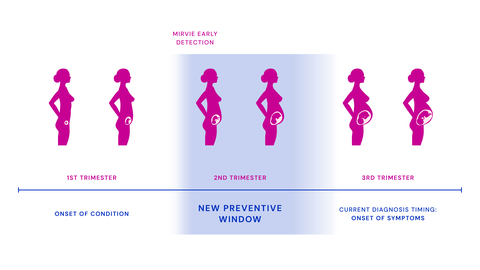SOUTH SAN FRANCISCO--(BUSINESS WIRE)--Mirvie, a pioneer in predicting unexpected pregnancy complications, today announced the publication of a study in Nature proving the proprietary Mirvie RNA platform is first to predict unexpected complications by revealing the underlying biology of each pregnancy. The research analyzed the largest and most diverse dataset of maternal transcriptomes to date. The platform opens a new window into pregnancy health for women to act and their doctors to intervene before unexpected complications become a crisis.
Unexpected complications affect one in five pregnancies, with large economic costs and lifelong health consequences for mom and baby.[1],[2],[3] Yet today, women and doctors lack a reliable way to detect complications before symptoms appear. The platform combines revolutionary analysis of tens of thousands of RNA messages from the baby, the placenta and the mom, with machine learning. It enables proactive, preventive, and personalized pregnancy care for the well-being of moms and babies.
The Nature study, “RNA profile reveals signatures of future health and disease in pregnancy,” was conducted in collaboration with leading researchers from 11 academic institutions and non-profit organizations from around the world. The study found the Mirvie RNA platform can effectively:
- Identify 75% of women who go on to develop preeclampsia including those with premature births. Only 20% of pregnancy complications can be predicted using today’s generalized risk assessments based on pregnancy history, race, ethnicity, body mass index, and medical history.[4]
- Detect pregnancy complications independent of a woman’s demographics or clinical factors. The diversity and magnitude of the study, which analyzed RNA in 2,539 blood samples from 1,840 women in the United States, Europe and Africa, advances the validity of the results and could help drive equitable care based on an individual pregnancy’s biology.
“This study demonstrates that RNA profiles reveal normal pregnancy development over time, enabling the early identification of moms at risk for pregnancy complications. The results demonstrate that we can predict preeclampsia early in pregnancy, before it becomes a threat to the mother and baby. This predictive ability is unprecedented in contemporary Obstetrics,” said the study’s senior author Thomas McElrath, M.D., Ph.D., Attending in Maternal-Fetal Medicine, Brigham and Women’s Hospital, Boston, and Professor of Obstetrics, Harvard Medical School.
Today’s generalized risk assessments do not take into account the specific biology of each pregnancy.
“This research shows the unique ability of the Mirvie RNA platform to directly detect the underlying biology driving adverse pregnancy outcomes, independent of clinical factors. Detection of early disease, at the individual level, promises more equitable care than the use of broad sociodemographic factors that often result in bias,” said Michal A. Elovitz, M.D., the Hilarie L. Morgan and Mitchell L. Morgan President’s Distinguished Professor in Women’s Health at the University of Pennsylvania, Chief Medical Advisor at Mirvie, and senior author of the study.
While fields like cancer care have advanced significantly, women’s health and pregnancy health have lagged behind. “This diverse, large, and global collaborative study validates that the proprietary Mirvie RNA platform provides vital information about pregnancy health and disease,” said Maneesh Jain, Ph.D., Co-Founder and CEO of Mirvie. “It is unacceptable that maternal health hasn’t seen meaningful innovation in decades. We are dedicated to shaping a better future for the wellbeing of moms and babies.”
Mirvie is conducting ongoing clinical research to further validate these results, to enhance the Mirvie RNA platform performance, and to improve the understanding of other pregnancy complications.
About Mirvie
Mirvie is shaping the future of pregnancy health by providing women and their doctors with an early detection window to intervene before unexpected pregnancy complications become a crisis. One in five pregnancies is impacted by complications that lead to lifelong health consequences for mom and baby. The proprietary Mirvie RNA platform uses a simple blood test to reveal vital information about a pregnancy’s unique biology and detect complications months before they occur. The idea for Mirvie was sparked by the personal experience of one of the founders whose daughter was born prematurely. Mirvie’s team of world-class scientists and entrepreneurs have brought to market category-first, non-invasive tests in both women’s health and in early cancer detection, used by millions today. Founded in 2018, Mirvie has raised more than $30 million in early-stage financing from top-tier investors, including Khosla Ventures, and Mayfield Fund. Mirvie is based in South San Francisco, California. To learn more about Mirvie, please visit www.mirvie.com.
McElrath and Elovitz are scientific advisors to and have an equity interest in Mirvie.
References:
[1]: March of Dimes, Preeclampsia Foundation, IDF, CDC, WHO, UN, Sedgh et al., Reinebrant et al., McNair et al., Mirvie co-morbidity analysis.
[2]: Sedgh G, Singh S, Hussain R. Intended and unintended pregnancies worldwide in 2012 and recent trends. Stud Fam Plann. (2014)
[3]:
- https://hcupnet.ahrq.gov/#setup for aggregate MDC14 and MDC15-related costs
- https://www.ncbi.nlm.nih.gov/books/NBK11362/pdf/Bookshelf_NBK11362.pdf
- https://pubmed.ncbi.nlm.nih.gov/28708975/
- https://www.liebertpub.com/doi/pdfplus/10.1089/pop.2009.12303
- https://healthcostinstitute.org/images/pdfs/iFHP_Report_2017_191212.pdf
- https://www.acog.org/clinical/clinical-guidance/committee-opinion/articles/2019/01/cesarean-delivery-on-maternal-request
- All costs adjusted to 2020 dollars via https://www.in2013dollars.com/Medical-care/price-inflation/
- EU grossed up from US based on https://ec.europa.eu/eurostat/statistics-explained/index.php/Government_expenditure_on_health and https://www.cms.gov/Research-Statistics-Data-and-Systems/Statistics-Trends-and-Reports/NationalHealthExpendData with EU27 being 31% of total US health expenditures ($1.1T vs. $3.6T)
[4]: https://obgyn.onlinelibrary.wiley.com/doi/10.1002/uog.19039




